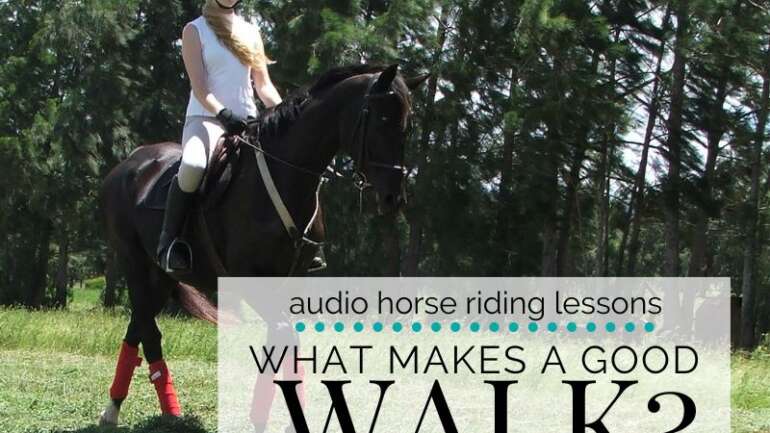Walking… Does your horse do it with a sense of purpose, or is he rather resembling a slowly rolling ball of jelly; going nowhere slowly? The problem many riders have is when we ask our horse to ‘walk on’, he becomes tense and stiff…
The walk, when it is a good walk, should be forward-moving, unrestricted, and natural. There should be a sense of purpose to it; evident in both horse and rider.
Unfortunately, as riders, we can often have a very negative influence over this gait, causing our horses to begin shuffling rather than walking! Here’s how you can begin to nurture what your horse naturally does in the walk, and create a good walk for both of you.
The Rhythm of the Walk
The first thing to do is begin identifying the rhythm your horse has in the walk. The walk is a 4-time beat. This means that each hoof is placed on the ground at a different point during each stride. The left back hoof is first, followed by the left front hoof. After which the right back hoof and, finally, the right front hoof. This means that the two hooves on one side of the body go first, followed by the two hooves on the other side.
When a horse has learned to adapt or change his way of going in the walk, often the hooves on either side of the body can seem to almost move together.
So instead of the regular 1…2…3…4…1…2…3…4…1…2…3…4… your horse’s rhythm begins to sound a feel more like 1.2…3.4…1.2…3.4…1.2…3.4… Now, essentially, this is also a rhythm. It’s a pattern that is repeating. However, it’s not a great quality rhythm! Meaning it’s not a good walk. This is where I would recommend beginning when you are assessing your horse’s natural rhythm in the walk.
Ask yourself; Are there four distinctive hoof beats? And are they all equally spaced? Meaning that all are given equal ‘time’ within each stride?
Seatbones and Hooves
What you can begin doing today is syncing your seat bones with your horse’s hooves. There is a direct connection between them and when you begin to understand it, you can be having a more positive influence. Your seat bones can help develop your horse’s walk. To begin creating a good walk.
Your left seatbone is, basically, moved by your horse’s left hip. Meaning that you can beign to know where your horse’s back left hoof is at any point in the stride by paying attention to what your left seatbone is doing.
By knowing what is happening underneath you, you can begin to time your aids more effectively in order to have a better influence. Things like asking for the trot. Or even the canter. Your half halt. Noticing straightness or bending. When you begin syncing your seat bones to your horse’s hips, you have the potential to become more effective.
Creating a Good Walk
I go into much more detail in more recent episodes of the Daily Strides Podcast on how to do this and so much more. I will link to them all here and I highly suggest you give them a listen and begin improving things today.
And, finally, if you would like to go further with your riding I highly suggest you give my free training series a go…Find the Gaps in Your Horses Training using this free audio series available for you to listen to in a private podcast feed – so just as easy as listening to the Daily STrides Podcast :) You can sign up for free HERE or visit https://stridesforsuccess.com/free
Happy Riding
Lorna
Get Audio Horse Riding Lessons and Begin Training Your HorseToday!
Right now, there are so many lessons, on all different topics, available for you on a Private Podcast Feed that delivers them straight to your phone, so you can listen as you ride your horse. Your own time, your own arena, your own horse… More Details HERE
Connection is an online membership for equestrians working alone to train their horse without a coach or trainer.
Get Support & Guidance in Your Riding
- Free Resource:- Find the Gaps in Your Horses Training
- Connection; the Online Membership for Equestrians
- Lunging for Riding – a 4-week program that gets results
- Groundwork for Riding – 4-week program (no arena required ;) )
- Daily Strides Premium Newsletter
- Online Community for Equestrian focusing on Planning and Mindset
- Equestrian Virtual Lounge Online Community

